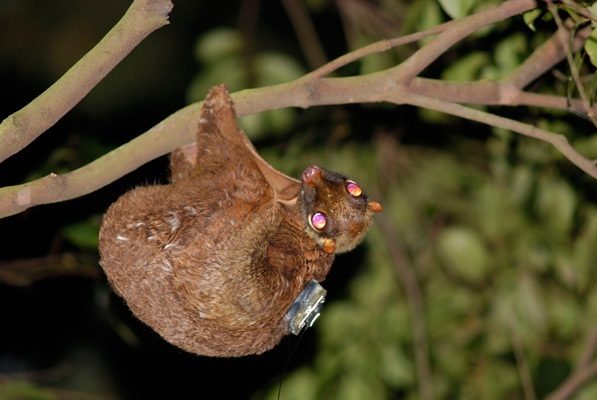More than 60 mammal species—like the famous flying squirrel—have adapted the ability to sail from tree to tree. Thrilling, yes. But what’s the evolutionary advantage?
超過60種哺乳動物——比如著名的會飛的松鼠——擁有從一棵樹跳到另一棵樹的能力。有些驚訝?事實確實如此。但這種能力有什么進化意義上的優勢嗎?
 One theory suggests gliding saves energy. So researchers tested that idea using colugos—mammals from Southeast Asia that turn into giant skin sails when they stretch out their legs.
One theory suggests gliding saves energy. So researchers tested that idea using colugos—mammals from Southeast Asia that turn into giant skin sails when they stretch out their legs.
有一種理論認為滑行節省體力。因此研究人員用飛鼯猴——一種來自東南亞的哺乳動物,當它們滑行時會伸展出四肢,變成一張巨大的翼膜。
The scientists placed accelerometers onto the backs of six compliant colugos. The data packs revealed that each colugo glided an average of a quarter-mile each night. But gliding isn’t as effortless as it looks. The researchers’ calculations suggest that flying actually requires one and a half times the energy of a conventional traverse. That’s because colugos prepare for a launch by climbing higher up the tree. And climbing’s a lot more strenuous than walking. Those findings appear in the Journal of Experimental Biology.
科學家在六只飛鼯猴背上安裝了加速度計。數據報顯示每只飛鼯猴平均一個夜里要滑翔1/4英里。但滑翔并不像看上去的那樣省力。研究人員的計算結果顯示飛行事實上要比普通的行走多用一半的力氣。這是因為飛鼯猴在準備滑行之前要爬上高高的樹,并且爬行比行走更耗體力。這些研究結果發表在《實驗生物學雜志》上。
So why do it? The upside is speed. Colugos can sail 10 times faster than they can tightrope through the canopy. Which leaves more time to snack. Plus, leaping into the air is an easy getaway from predators. In the end, it’s not too different from human flight—costs more, but way faster.
既然這樣,那么它們為什么要這么做?因為滑行比在樹叢中飛檐走壁要快上10倍,這也讓它們有更多的時間睡覺。此外,滑行有助于它們逃脫天敵的追捕。到頭來,這跟人類的飛行一樣——花費更多,但更加省時。
來源:可可英語 http://www.ccdyzl.cn/hangye/201201/169227.shtml One theory suggests gliding saves energy. So researchers tested that idea using colugos—mammals from Southeast Asia that turn into giant skin sails when they stretch out their legs.
One theory suggests gliding saves energy. So researchers tested that idea using colugos—mammals from Southeast Asia that turn into giant skin sails when they stretch out their legs.










